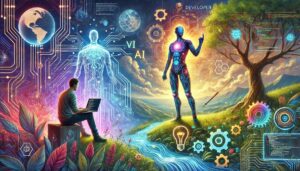
Establishing the facts of the real world for developers
The rise of artificial intelligence (AI) has sparked debates across various industries, with one pressing question being: “Will AI replace the developer role?” As a company at the forefront of technological innovation, Mind Spark Technologies recognizes the importance of addressing this concern. In this blog, we’ll explore the capabilities of AI, its current limitations, and the future landscape for developers.
The Possibilities of AI in Development
AI has made significant strides in recent years, particularly in automating repetitive and time-consuming tasks. Here are some areas where AI is already making a substantial impact:
1. Code Generation: Some software such as OpenAI’s Codex and GitHub Copilot can write or auto suggest portions of code with respect to natural language commands. This can help it can expedite the expansion process and help developers in writing stub codes.
2. Bug Detection and Fixing: AI applications have the ability to detect bugs and offer solutions to them. They are also capable of performing a code review at a much faster pace than a human would take to accomplish the same enhancing the quality of the codes and saving a lot of time that could have been spent on debugging.
3. Automated Testing: This ability can create and run tests on its own so that it can check that the new code being implemented does not affect the functionality of the client’s prior code. Through this, the organization is easily able to adopt more efficient and more effective penetrative tests.
4. Code Refactoring: From this we can deduce that the AI can make suggestions on how the code can be made better, that is cleaner, more efficient, and easier to manage.
That is why the significant role of artificial intelligence in changing the paradigm of social development is accompanied by certain limitations.
Despite these advancements, AI has limitations that prevent it from fully replacing human developers: Despite these advancements, AI has limitations that prevent it from fully replacing human developers:
1. Creativity and Innovation: AI has no creativity and it cannot invent things on its own. Generation of new software solutions implies new approaches, which are still beyond AI.
2. Complex Problem-Solving: Most development tasks have a problem solving component that cannot be understood fully without developing an instinct for it. Today, AI can do a lot but it cannot think like a human being when it comes to these tasks.
3. Automated Examing: AI can help in generating and executing tests in a very efficient way as to check if new codes interfered with the correct working of the system. This leads to the enhancement of the overall efficiency of testing as well as better completion of the entire testing process.
4. Script Refactoring: It can become helpful in further enhancing the already existing code so that the code is more readable, efficient, and manageable.
The Restriction of Artificial Intelligence for Development
Despite these advancements, AI has limitations that prevent it from fully replacing human developers: Despite these advancements, AI has limitations that prevent it from fully replacing human developers:
1. Creativity and Innovation: AI is not gifted in the aspect of creativity and or even inventiveness. A new method of solving a certain problem also may need creative ideas and this aspect AI fails to fulfill.
2. Complex Problem-Solving: Most development tasks comprise problem-solving which is not obvious and requires comprehension and a natural feel for it. By all means, AI can help, but it can never replace man’s brain to think in the way required for these tasks.
3. Understanding Context: Due to the lack of any social interaction AI may fail to grasp the larger view of an endeavor or perceptive the requirements of the business. AI cannot make decisions when project developers require it as they can only make decisions when they fully understand the goals and limitations of the project.
4. Ethical and Social Considerations: It signifies that the developers have to be aware of the ethical consequences they possess, the users they design for, and the society they are a part of while designing the software apace. These considerations involve aspects of empathy and moral judgment something that is still a weakness in AI.
The Updates in Store For Developers
Pursuant the current state of AI and its known restrictions and challenges, it is possible to speak about changes in the developer’s position rather than its complete disappearance. Here are some ways AI is expected to change the landscape for developers: Here are some ways AI is expected to change the landscape for developers:
1. Enhanced Productivity: AI tools will remain helpful in optimizing developers’ productivity through automation of repetitive tasks so that developers can only concentrate more on issues that require the use of their creativity.
2. New Skill Sets: Some new competencies that are likely to be required among developers include the following. This entails knowing the techniques of utilizing the existing and future unveiled AI tools appropriately and incorporating AI solutions within their projects.
3. Collaborative Environment: Hence the future will calculate where the AI and the developers will work hand in hand. Different and uncomplex processes will allow AI to work while the developers will focus on providing challenging and tactical decisions.
4. Continuous Learning: There is a new advancement in AI technologies, which makes it necessary for the developers to learn new things and stay abreast with the new developments in AI tools and trends.
In this week’s readings, we learned that artificial intelligence is currently affecting the software development industry without aspiring to eliminate developers. Instead, AI was integrated as a strong point that enables developers to increase their potential with the help of intelligent tools. At Mind Spark Technologies, AI Marries Man because AI means wise contribution while human means creative contribution, therefore the future of development is closely tied between the two systems. This way developers will have much more creative and engaging work to do solving real human problems which will lead to the development of real value-added solutions.


